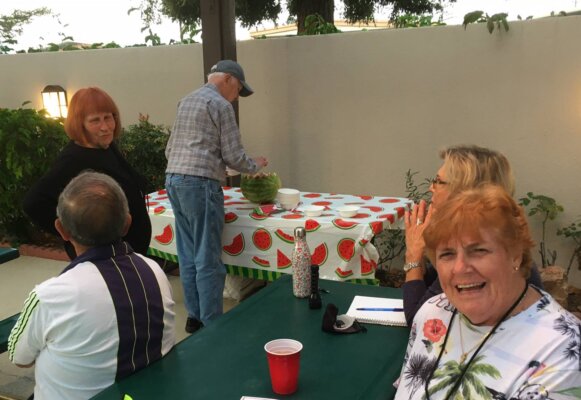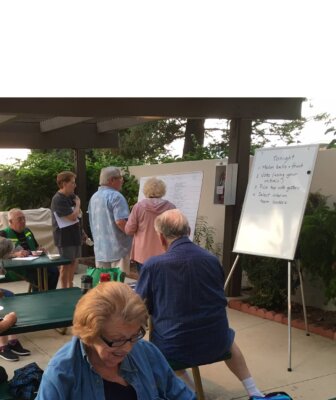
After 18 months of not seeing each other’s faces, it was time for our Neighborhood Emergency Response Group to get back together. We needed to revive our group. We needed new ideas. We needed to regain some momentum!
Here’s a quick story of how we have progressed over the past two months. While this describes a Neighborhood Emergency Response Group, I think the step-by-step activities could be used by just about any group!
First step: Make sure a face-to-face meeting is safe.
When our “revival” started, COVID was declining in our community but we were still cautious. After all, the goal of a Neighborhood Emergency Response Group is to protect health and lives, and not threaten them!
So, while our clubhouse had been “officially re-opened to groups,” we decided that masks would be required. (As you can imagine, a few people then declined to come. . .)
In contrast, we held our most recent meeting, just yesterday, outside in a patio area. We enjoyed plenty of fresh air and masks were optional. The dynamics improved, along with the acoustics!
Second step: Advertise “Revive Our Group” by promising that everyone will be involved.
Our meetings have traditionally taken place in a meeting room, with tables and chairs and someone leading the discussion. Shy attendees are able to get through without ever really joining in.
For our first Revival Meeting, we tried a new format.
Here’s how it worked.
Our meeting was advertised as having a goal of “collecting new ideas.” After a brief catch-up of what had happened during the pandemic shut-down, we identified four areas that we wanted to work on:
- Group purpose and positioning
- Recruitment of new members
- Education and training
- Budget and sponsorships
During this discussion, we gave every attendee a pad of yellow (or other color!) sticky and a pen. We invited them to write down their ideas, one idea per sticky. It was billed as a “brainstorm!’ (“Every idea is good. No judgment calls.”)

We labeled sheets of paper with the themes. (We happened to have bright pink paper, but any color will work!) At the given time, attendees all got up and pasted their individual stickies on the appropriate sheets. There was some jostling but it was good to get people out of their chairs. Here’s what one of the sheets looked like after the stickies had been posted:

Third step: Document EVERY idea, no matter how new or unusual.
After the meeting, I captured all the individual sticky ideas and turned them into a more formal list. I sent out the list with Instructions: “Please consider which ideas should be on our ultimate “Top Ten” list.”
Fourth step: Let your group members vote for their favorites.
A month after our first meeting we gathered for our second meeting. It was outdoors, face to face! We started with refreshments (melon balls in carved up watermelon – labor of love from one of our volunteers!). We discussed each of the ideas on our Master List, and then people went over to the board where ideas were listed and they voted.
People voted for the activities they thought would be most do-able and most productive.
When they placed their votes (their initials) into the column labeled, “I will help,” we suddenly had a whole group of volunteers!
Fifth step: Pick the Top Ten,” assign an interim team leader – and let everyone get started!

The picture above shows just the top few lines of one of the two big ballot sheets.
- Note the column headers: Priority, Activity or Event, “I will help.”
- “Votes” are indicated by the sets of initials after each activity or event.
- The more sets of initials, the more popular or desirable the activity.
- The red checks indicate which events were chosen for the Top Ten. (Actually, we ended up with only 8 out of a total of 23 suggestions.)
- The red circles show the person chosen as interim team leader. Team leaders got a short list of “Project Planning Tips” to help them get started.
What about the activities and the people left over?
My next step will be to again document the Top Ten and list the volunteer team members. At the same time, I’ll encourage “orphans” to join in one of the first teams created or, if they want, to simply proceed on their own to develop their favorite activity.
I’ll report on how all that goes in an upcoming Advisory.
Conclusions from our first efforts to “Revive our group.”
- Starting with refreshments works better than waiting until the end. If the meeting goes too long, people want to leave. (In our case, waiting too long would have put us all in the dark!)
- Using pens and stickies to capture people’s input was particularly successful at engaging those people who aren’t comfortable speaking up.
- Brainstorming – “Just come up with ideas, every idea is good.” – works to generate lots of ideas.
- Sorting through all the ideas to pick the best (easiest? most popular?) takes time. It took a LOT of time. But our goal was to create energy by engaging more of our group members – and the effort paid off.
Just a couple more photos while it’s all still fresh in my mind!


Within about 20 minutes from the time the photos were taken, this entire patio was dark. Fortunately, people brought lanterns (emergency lighting!) to allow us to finish up.
Our Watermelon Party doesn’t end this story. I’ll be writing again about the various events and how they develop. If you have held some successful events designed to engage group members, pleas let us know the details. We all need ways to stimulate participation and revive our groups!
Virginia
Your Emergency Plan Guide team
P.S. You know, of course, that we’ve published a whole book with Emergency Preparedness Meeting Ideas. It has over 100 pages of ideas for meeting topics and formats to get you started or keep you busy.
Don't miss a single Advisory.
Thank you for subscribing.
Something went wrong.
